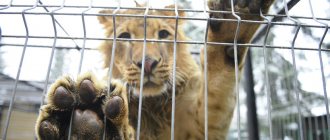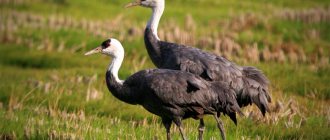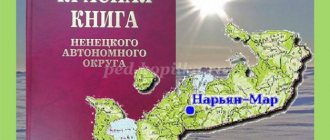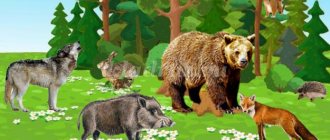Red Book of Animals of Russia - what is it?
Getting acquainted with the animals of the Red Book should begin in childhood. Children of primary school age will understand from a very young age that the destruction of animals should not be allowed. Children should be explained that the animal world should be protected, and that endangered rare species should be treated especially carefully.
This article is a tip for parents, teachers, and older children who want to find out for themselves and tell their children about the Red Book, to get acquainted with rare species of various animals listed in the Red Book. Brief descriptions and photographs of rare animals are presented here.
There are a huge number of animals in the world. But, unfortunately, many of them are at the stage of extinction. Populations of some animal species are gradually disappearing from the face of the globe; many species have already become extinct.
The reason for the decline in animal populations is primarily human activity. Most often, people can unknowingly harm not only animals, but also plants. This occurs as a result of environmental pollution by atmospheric toxic substances, deforestation, during the development of new lands and other anthropogenic actions. But, unfortunately, some people deliberately destroy animals. Such people are called poachers. For the sake of valuable fur, meat, and tusks, poachers destroy animals all over the world. The problem of poaching is very serious in many countries around the world.
The following animals no longer exist in nature:
- Tarpan horse
- Turanian tiger
- Sea cow
- Tour
Now these species can only be found on the pages of encyclopedias. But once they existed in our nature, they were a numerous part of the fauna.
Important: the Red Book was created . The book is called this because the color red symbolizes danger and anxiety. The book exists to draw the attention of all people to the existing problem of extinction of animal and plant species. The Red Book includes not only animals, but also rare species of plants and fungi. Our country also has a Red Book of Animals.
The pages of the Red Book have their own colors, which indicate:
- Black - the animals listed on these pages are already extinct.
- Red - indicates animals on the verge of extinction.
- Yellow - rare species of animals that are not yet extinct.
- Green—restored populations.
- White - species of animals that are in doubt of extinction.
The Red Book of the USSR first appeared in 1978. Since then, the book has been supplemented many times with new names of animals. The Red Book and the animals listed in it are protected by law. The Red Book is a state document.
There are regional books, in them you can see rare animals of a certain region. A lot of work is being done to identify rare and endangered species of animals. Some species are called into question, and the Red Book also makes it possible to preserve the number of rare animals and revive their population. For example, thanks to human protection and care, it was possible to restore such animal species as elk, river beaver, stag beetle, and belladonna.
New version of the book
After the collapse of the USSR and the emergence of Russia as a separate and independent state, the Ministry of Ecology was urgently created. He was tasked with creating a book of rare wildlife species located on the territory of the Russian Federation. For the first time, people saw the Red Book, which reported on rare animals living throughout the state, in 2001 . That’s how long it took to collect all the information on wildlife. There is also an international version of the book.
In total, the following were entered into the book of the Russian Federation:
- 8 large species of amphibians located on the territory of the country or related to their presence in the vast expanses of Russia;
- 21 species of amphibians;
- 128 vertebrate fish;
- about 74 mammals.
After distributing all individuals into classes, the book contained 231 groups of living organisms.
The division into extinction threat categories was constructed as follows:
- The species are under threat of complete extinction. The number has reached critical levels. This subtype indicates that the species listed in the category may become extinct in the near future.
- The number of individuals is rapidly declining. The rate of decline of species is so fast that they will soon belong to the first subtype.
- Marked "rare". The species' territory is limited. They are small in number and have special control over them.
- The status of the individuals is not determined. For these species, for one reason or another, there is no data sufficient to determine the category. In this regard, special control measures have been established over them before assigning them to any category. If a species does not fall under at least one of the classifications, it will remain under this item.
- The numbers are recovering. Naturally or with the use of certain measures, animals begin to restore their population. If the limit is exceeded, they will be removed from the Red Book.
There was also a subtype marked "0". This meant that this species most likely disappeared completely. This includes known invertebrates that have been extinct for hundreds of years due to various factors, and vertebrates that have been known to go extinct for more than 50 years.
Mammals of the Red Book of Russia: names, photos, descriptions
The list of endangered animal species is very long. We will list the most famous of them.
Amur tiger
One of the largest representatives of the cat family. In size it is second only to the Bengal tiger. The Amur or Ussuri tiger lives in the Russian Far East. The tiger is adapted to survive in cold conditions thanks to a thick layer of fat. Amur tigers live alone. Sometimes females can be found in a group. The weight of the animal can reach 250 kg. This species requires a huge territory in which it will be the owner (0.5-1 km). In the wild, a tiger lives 15 years; in captivity, it lives up to 20 years.
Amur tiger
Polar bear
A large predator that lives near the Bering and Chukchi Seas. The Chukotka range of polar bears is considered the largest in the world. High mortality among young animals is common among polar bears. 10-30% of cubs die, and bears reproduce slowly. This makes the species look vulnerable. The body weight of a male can reach 450 kg, and cubs are born weighing 700 grams. The polar bear is considered a symbol of the Arctic.
Polar bear
Red Wolf
A rare species of canid. The red wolf differs in many ways from its cousins, the gray wolves. It can be confused with a fox; it is distinguished by a reddish tint of its skin and a fluffy tail. Scientists put forward the opinion that it was not man who caused the extinction of this species, but nature. It is believed that gray wolves are to blame for the disappearance of their brothers, with whom red wolves cannot compete in strength.
Red Wolf
Bison
This huge representative of artiodactyls lives on average 23-25 years. Basically, bison live in nurseries. This is how their population is preserved. They are also released into the wild. Bison live in small herds consisting of females and calves. Bulls live alone. The bison, as a rule, does not attack humans and behaves calmly.
Bison
Altai mountain sheep
Lives in the mountainous regions of Altai, Eastern Siberia. Due to the fact that the species lives in hard-to-reach places, it is difficult to track its numbers. Mountain sheep are often attacked by wolves and other predators, which reduces their numbers. It is famous for its luxurious horns, which makes it a tasty prey for hunters.
Altai mountain sheep
Snow Leopard
Another name is snow leopard. A small part of the total number of snow leopards lives in Russia (10-20%). Habitat in Russia - Buryatia, Krasnoyarsk Territory, Altai, Khakassia. The snow leopard is a lithe big cat with a beautiful smoky gray coat and ringed spots. The snow leopard lives in the wild for about 13 years; in captivity, its lifespan increases to 21 years.
Irbis
bottlenose dolphin
Bottlenose dolphins are very friendly dolphins. They do not attack humans; on the contrary, they show interest. There are known cases when schools of bottlenose dolphins surrounded people in a ring, protecting them from sharks. There are also cases of bottlenose dolphins rescuing drowning surfers. These are very smart animals. It has been proven that in captivity they are often exposed to stress, which affects their life expectancy.
Dolphin
Caucasian European mink
It is a subspecies of the European mink. It lives in the Caucasus in small rivers and streams. For a long time, mink were destroyed in order to obtain valuable fur.
Caucasian mink
Mammals
The list of mammals in Russia includes about 300 species. Of these, several dozen representatives of the animal world are included in the KKRF. They belong to the following groups:
- Predatory;
- Insectivores;
- Chiroptera;
- Rodents;
- Cetaceans;
- Pinnipeds;
- Artiodactyls;
- Odd-toed ungulates.
Amur tiger
The Amur or Far Eastern tiger lives in the southeastern part of Russia. This is a protected area spreading along the banks of the Ussuri and Amur rivers. According to the 2015 census, the number of these animals was 523-540 individuals.
Amur tiger
For example, in 2013 there were fewer tigers - 450. The main reason for the extinction in the 19th century was human activity - every year the number of tigers decreased by an average of 100 individuals.
Experts plan to resettle Amur tigers in the area of the Pleistocene Park (Yakutia).
Then it will be possible to increase their population to 75 individuals. But for this it is necessary to increase the population of artiodactyl animals, which form the basis of the tiger’s diet. In addition to deer, roe deer, and moose, they feed on small animals, birds, and fish. Tigers need about 10 kg of meat per day. Interesting fact : the Amur tiger is the only subspecies that has a 5 cm thick layer of fat on its belly. It helps animals survive even at very low temperatures.
Far Eastern leopard
Amur leopard, East Siberian leopard - this predator has up to 5 names. It is considered the rarest subspecies. According to 2021 data, 87 individuals live in Russia. Their habitat is the Land of the Leopard National Park.
Far Eastern leopard
The decline in the number of Far Eastern leopards is associated with poaching. This includes the animals that these predators feed on. People are also destroying forests, a natural habitat. Due to the small number of the species, leopards reproduce within the same population, which has a bad effect on genetics.
The predator is nocturnal and hunts alone. The diet consists of other animals of any size, mainly ungulates. Large prey lasts a leopard about a week.
Snow leopard (irbis, snow leopard)
A large predator from the cat family, it is common in the mountains of Central Asia. In Russia these are Altai, Tuva, Krasnoyarsk Territory, Khakassia, Buryatia, and the Eastern Sayan mountain system. Due to the difficult conditions in which the snow leopard lives, it is one of the least studied species of its family. Perhaps the snow leopard population has not completely disappeared precisely because of its habitat.
Snow Leopard
According to estimates in 2021, the number of snow leopards in Russia is 63-64 individuals, of which there were more than 10 kittens. Evidence suggests that the population remains relatively stable. 2-3% of the total number of snow leopards live on the territory of the Russian Federation.
Officially, hunting snow leopards is prohibited. However, poaching continues to harm their population. Predators also suffered as a result of mass poisoning of rodents, which are part of their diet, with pesticides. Snow leopards lead a predominantly solitary lifestyle, but family groups are sometimes found. They feed on ungulates and small animals.
Central Asian leopard or Caucasian leopard
In Russia it is found in the North Caucasus. The Central Asian leopard lives in forests and dense bushes, preferring to stay close to rocks and stones. Predators feed on medium-sized ungulates (deer, mouflon, wild boar, etc.), and sometimes on small animals.
Central Asian leopard
The problem of the population of Caucasian leopards is more than relevant. There are about 1000 of them preserved in the world. The main cause of extinction is human activity. The exact number of animals within the Russian Federation has not been established. However, in 2007, a special program was approved to restore the leopard population in the Caucasus.
Sea lion
The sea lion or northern sea lion is the largest species in the eared seal family. Belongs to the second category of animals, that is, those whose numbers are declining. In Russia, sea lions began to noticeably disappear in 1890-1990 - from 115,000 to 15,000 individuals. According to the latest data, their population in Russian waters is about 20,000.
Interesting: Why do bees make more honey than they need?
Sea lions
Animals are found in the waters of the Sea of Okhotsk, Bering, and Japan, as well as along the Kuril Islands and Eastern Kamchatka. Sea lions prefer coastal areas and islands. Their life cycle consists of migrations and rookery periods.
The exact reason for the decline in the number of northern sea lions has not been established. Main factors: fishing, water pollution, warming, catching fish, which forms the basis of the diet of sea lions. Steller sea lions also have natural enemies - killer whales and brown bears.
Walrus
Walruses are the only representatives of their family. Juveniles are easy to distinguish from adults: the latter have huge tusks. According to the main classification, these pinnipeds are divided into Pacific and Atlantic. Another subspecies is the Pacific Laptev walrus.
Walrus
Interesting fact : the walrus is the largest species in the group of pinnipeds after the elephant seal. However, walruses and elephant seals are not found in the same areas, so the walrus family can be called the largest in its range.
The Atlantic and Laptev walruses are listed in the KKRF. The population of the first species in Russia is about 20 thousand, the second – up to 10 thousand individuals. In the case of the Atlantic walrus, the number of individuals was significantly reduced due to uncontrolled fishing. The population is also affected by climate change, natural enemies, and parasites.
Walruses live in the waters of the Chukchi, Bering, Kara, East Siberian, and Laptev Seas. They prefer coasts and do not move long distances.
harbor seal
The common seal is a predatory mammal, two subspecies of which (European and Kuril) are listed in the Red Book of Russia. Seals are common in the seas belonging to the Arctic Ocean. They live in the coastal zone, bays where strong winds do not blow. There is also a population of seals on the Commander Islands.
harbor seal
The number is declining for several reasons: poaching, global warming, human activity in the coastal zone, attacks by natural enemies (polar bears, killer whales). The number of individuals has recently been 4-6 thousand.
Narwhal
The narwhal is the only representative of its genus. It is included in the 3rd category of animals, as a rare species with a small number of individuals. The exact number of narwhals is unknown, but in 2021 scientists discovered about 30 individuals, including calves.
Narwhal
The usual habitat is the waters of the Arctic Ocean and the northern part of the Atlantic. Narwhals suffer most from poaching, as well as from natural predators - killer whales, polar bears, polar sharks.
bottlenose dolphin
The bottlenose dolphin (large dolphin) is a species of dolphin. There are several of its subspecies. In particular, the Black Sea bottlenose dolphin, which lives in the waters of the Black Sea (about 7 thousand individuals), is listed in the Red Book of Russia.
bottlenose dolphin
Since 1996, fishing for these dolphins has been prohibited. Bottlenose dolphins are disappearing for many reasons: fishing, netting, poaching, pollution of ocean waters with household waste, noise pollution.
Bottlenose dolphins prefer a sedentary lifestyle or move in small groups. As a rule, they live near the coast, which is explained by the nature of their diet. The diet of dolphins includes a variety of fish.
Interesting fact : a characteristic feature of bottlenose dolphins is their well-developed cognitive abilities. For example, they understand gestures, monitor their behavior, imitate people, etc.
Blue whale
The blue or blue whale belongs to the category of baleen whales. It is both the largest representative of cetaceans, and also, apparently, the largest animal that has ever lived on the planet (up to 33 m in length and weighing more than 150 tons).
Blue whale
Among the three subspecies, the northern blue whale is listed in the CCRF. It is considered typical because it was the first discovered and described. In general, blue whales are considered cosmopolitan - that is, widespread. However, they are rare in Russian waters. For example, near Cape Lopatka (Kamchatka).
The greatest threat to whales has become active fishing, which has been officially prohibited since 1966. The exact number of individuals is difficult to establish - different sources provide conflicting data. If in the 19th century the number was several hundred thousand, now it is up to 5000.
Currently, blue whales are suffering due to collisions with ships, water pollution, and increased noise levels. They also get entangled in nets.
Polar bear
The polar bear ranks second among the largest land predators (after the saltwater crocodile). Within the Russian Federation, the species is distributed in the waters of the Bering and Chukchi Seas, as well as on the Arctic coast of the Chukotka Autonomous Okrug. This is where the largest population in the world is concentrated.
Polar bear
Polar bears feed on marine mammals. They lead a solitary lifestyle. The animals are threatened by poaching, since hunting them has been prohibited in the Russian Federation since 1956. At the same time, polar bears have low reproductive potential. The number of species in our country is up to 7000.
Interesting: Spiders









